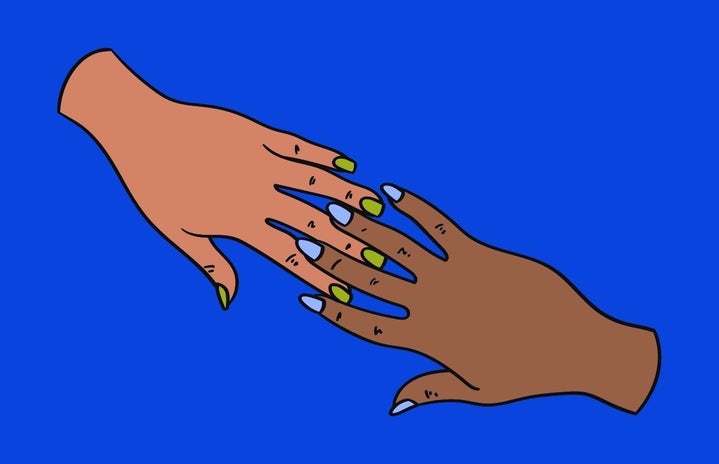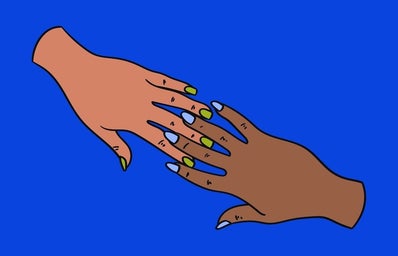Ever since I was a child, I have loved stories. I used to read them, listen to them, watch them and even write my own. My favorite genre has always been romantic comedy. Even though I love a story with the ability to surprise me, there is something reassuring to me about the predictable story arc of a rom-com. From the meet-cute, to the falling-in-love, to the conflict (which they could have avoided with some basic communication), and finally, to the resolving of the issue with a confession of love and some kisses – the rom-com has allowed me to escape to a fantasy land where love exists over and over again.
However, something I became painfully aware of as I grew older was the fact that all of my favorite rom-com protagonists were white women. I am half-Finnish, half-Israeli, and my upbringing was a genuinely very middle-class, “typical” Finnish upbringing (but instead of a picket-fence, we had hawthorn shrubs and I spent my childhood trying to avoid piercing my foot with a thorn like my dad once did.)
I always forgot, and still keep forgetting, that due to my darker skin tone, dark brown hair and brown eyes, I don’t register as a Finnish person to many. But, that is what I am. I was born there, grew up there, and until I moved away to the UK for university, I had never lived elsewhere – but his (painful) discussion is one to be had at a different place, and at a different time.
Now, I would be lying if I said I was never able to identify or find pieces of myself in the heroines of these romantic comedies I enjoyed, because I did. Growing up as the youngest of all of my siblings and cousins, I had everybody wrapped around my little finger, and therefore, the slightly over-the-top, self-absorbedness of Elle Woods, Cher from Clueless, and Poppy from Wild Child, all felt familiar to me (don’t get me wrong – this is not a good thing.) I watched 10 Things I Hate About You and 13 Going On 30 over and over again out of admiration for the main female protagonists.
However, the main similarity shared by these characters? They are all white.
I used to not care because I never even realised that I was somewhere outside of this “norm”. But, I can pinpoint my pre-teen years as the pivotal time when I began to realise that there was a gap between what I was thought to be and who I knew myself to be.
In my head, I was just like any other Finnish teenager, and I never considered my skin tone to be a significant part of who I was. I had grown up with the same friends around me, and it wasn’t until I went to a bigger school at age thirteen, that I began getting questions about “where I was really from”.
Suddenly, I started becoming aware of the fact that I looked different. And suddenly, I also realised that my favourite characters from my favourite films and shows also did not resemble me in any way. I continued consuming the entertainment I loved most, but grew increasingly aware of this. At the same time, I grew more insecure about the way I looked, and began feeling afraid that love wasn’t in the cards for me. After all, you never hear about the protagonists’ non-white friends finding love; they’re merely there to cheer on the main couple. Was this going to be my destiny?
Well, obviously not. But it took me way too long to understand this because it took a good decade for films to slowly begin to resemble the real world and to offer protagonists who I could relate to in deeper ways.
Identity is a difficult thing to grasp because of its ever-changing fluidity. One thing is for sure, though; not seeing yourself represented in all of your complexity is hurtful.
This is also something really difficult to try and explain to another person if they haven’t experienced it. Often, I feel like I sound like I’m over-reacting; asking for too much; taking too much space. But is it really so wrong to crave to be represented, if at all, at least as who we are; contradictory, intricate, unique human beings?
So often, the only brown characters I see are completely defined by their ethnicity. Similarly, too often any minority character is only defined through their one minority-trait, while a white straight character can be almost anything.
In recent years, this has been changing. Little by little I have seen myself truly represented on the big and small screens. The subtleties of trying to navigate life and love while balancing between different cultures has been depicted in films such as To All The Boys I’ve Loved Before and Crazy Rich Asians.
Love, Simon showed us that, in the end, teenage love is the same no matter who you are and who you love. The ethnic landscape of the New York City of Someone Great actually feels believable for once, and the way in which the true love story is about female friendship just adds to another dimension that has been lacking from this genre since… well, forever.

Don’t get me wrong – there is still a very long way to go. For example, what comes to representation of disability in media, many movies have missed the mark. Me Before You, a popular book-turned-movie, featured a paraplegic main character, whose entire identity was based around his disability and his hatred towards it. Obviously, many disabled advocates were disappointed by this. This narrative only perpetuates the sub-conscious way of considering disability as the worst possible thing that could happen to a person. Similarly, portrayals of mental illness in film and television have resulted in adverse outcomes, as in the case of the Netflix show 13 Reasons Why. Sometimes, while creators set out to do something good, the outcome is not what was expected. That is where it is of utmost importance to listen, to understand, and to accept that sometimes we make mistakes.
It is so incredibly refreshing to see stories of diverse people and diverse experiences – but without those stories becoming oversaturated with their diversity. People of color, LGBTQIA+ people, people with disabilities… they – we – are more; complex human beings who self-sabotage, lash out, laugh, love, cry and possess immense talent and potential. It is about time that film and television begins to reflect this. Demanding this is not in any way radical.
Quite frankly, we still have a long way to go, especially in terms of portrayals of different kinds of disability. However, shows such as Special and Atypical (while being far from perfect) have begun paving the way for a more nuanced portrayal of disabilities.
While Hollywood still seems to be taking baby steps in the direction of diversity, it has been reported that when they do take this step, it pays off. According to an article in the Business Insider, movies with more diverse castings tend to gross more income at the box office. While a direct causal relationship is difficult to prove here, based on my own experience as well as the experiences of peers who fall outside of the “white, straight, able-bodied” norm, there is a level of elevated excitement which comes with the representation of your own marginalised identity, whether it is on the big or small screen, or on the pages of a book.
There is nothing wrong with the rom-coms I grew up loving and watching. I will continue to rewatch them, enjoy them, and be entertained by them. But to a certain extent, I will always feel like I cannot fully identify with those stories – not in a way that I want to.
We love stories we can identify with, stories we relate to. Not providing adequate representation shuts out audiences. To me, that is many things, but above all completely absurd. The world of 2019 is diverse and with that comes the endless beauty and plurality of experiences. It is about time we have begun to see more and more of it.
Hopefully, one day articles like this will become obsolete when diversity is a rule rather than an exception.



